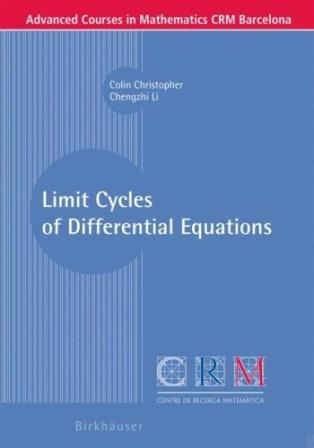 |
Limit Cycles and Differential Equations
Colin Christopher and Chengzhi Li
Series: Advanced Courses in Mathematics - CRM Barcelona
Birkhäuser (2007), 171 pp.,
Price: US$39.95
ISBN 978-3-7643-8409-8. |
Reviewer: Douglas S. Shafer
Mathematics Department,
University of North Carolina at Charlotte,
Charlotte, North Carolina, U.S.A. |
This book is a set of polished lecture notes based on lectures given by the
authors in the Advanced Course on Limit Cycles and Differential Equations
at the Centre de Recerca Matematica at the Universitat Autonoma de
Barcelona in June of 2006 as part of its year-long research program on
Hilbert's Sixteenth Problem. As stated in the forward,
"The common goal of the two sets of notes is to help young mathematicians
enter a very active area of research lying on the borderline between dynamical
systems, analysis and applications." The book is divided into two parts of
roughly equal length, each one written by one of the authors. The first, by
Colin Christopher of the University of Plymouth, is entitled "Around the
Center-Focus Problem." The second, by Chengzhi Li of Peking University, is
entitled "Abelian Integrals and Applications to the Weak Hilbert's Sixteenth
Problem." Both parts of the book are written at a high level and, in keeping
with the purpose both of the book and the lecture series, are appropriate
really only for those whose research interests center on the theory of limit
cycles in polynomial systems. Each one has an extensive bibliography; even
allowing for overlap there are probably well over 200 entries.
To describe the specific content of the book we must first recall that the
second half of Hilbert's Sixteenth Problem is to obtain a uniform bound \(H(n)\)
on the number of limit cycles that can appear in the phase portrait of any
planar system of ordinary differential equations whose right hand sides are
polynomials of degree at most \(n\). Let \(H(x,y)\) be a polynomial of degree
\(m \geq 2\) that vanishes at the origin and whose level curves near zero
include a family of ovals about the origin, let \(P(x,y)\) and \(Q(x,y)\) be
polynomials for which \(\max\{ \deg P, \deg Q \} = n \geq 2\), and consider the system
\(\dot x = -H_y + \epsilon P,\)
\(\dot y = H_x + \epsilon Q,\)
|
(1) |
a polynomial perturbation of a Hamiltonian system with a center at the origin.
The abelian integral (by which is meant the integral of a rational 1-form
about an algebraic oval) \(I(h) = \int _{\gamma_h} P \, dy - Q \, dx\), where
\(\gamma_h\) is the small oval \(H = h\) about the origin, is the first order term
when the displacement
along a transversal in the period annulus, in one turn about the origin, is
expanded in powers of \(\epsilon\). The weak (or tangential or
infinitesimal) Hilbert 16th Problem is to find the maximum number
\(Z(m,n)\) of isolated zeros of the abelian integral \(I\). The reason for the
terminology is that this number is an upper bound for the number of limit
cycles that bifurcate from the period annulus for small \(\epsilon\), hence
\(\widetilde Z(n) = Z(n+1,n) \leq H(n)\).
In his first chapter Chengzhi Li reviews this theory and similar matters and
gives a survey of known results. His second chapter is a careful and thorough
treatment of the relation of abelian integrals to the creation of limit cycles
from the period annuli of Hamiltonian centers (with a section on more general
centers). The third chapter discusses methods for estimating the number of
zeros of \(Z(m,n)\), including methods based on Picard-Fuchs differential
equations, the argument principle, and averaging. Finally, his last chapter
presents the unified proof, by him and his collaborators, that
\(\widetilde Z(2) = 2\).
In his first chapter Colin Christopher outlines the center-focus problem and
explains its relevance to the problem of counting limit cycles in polynomial
systems. Centers of polynomial systems typically arise through two
mechanisms, presence of sufficiently many invariant algebraic curves (the
Darboux theory) and presence of symmetry, which are discussed in the next
four chapters. This comprises the first half of this part of the book. The
remainder of this part of the book is devoted to approaches to centers based
on the concept of monodromy, the study of how objects that depend on a
parameter, but are in some regard locally constant, change as the parameter is
varied along a non-trivial path. The first situation treated gives the flavor
of the rest. Let us consider the system (1). The origin is a
tangential center if \(I(h) \equiv 0\) for \(h\) sufficiently near zero. It
is proved that for a generic Hamiltonian a tangential center occurs when the
1-form \(P \, dy - Q \, dx\) is ``relatively exact," meaning that it has the
form \(dA + BdH\) for some polynomials \(A\) and \(B\). The method of proof is to
complexify and show that in moving around a non-trivial loop in \(\mathbb{C}\) minus the
critical values of \(H\) one obtains the whole homology group
\(H_1(\varphi_h, \mathbb{Z})\) of the Riemann surface
\(\varphi_h = \{(x,y) : H(x,y) = h \}\). This result (first proved by
Yu. Ilyashenko) can then be used to count the dimension of the space of
non-trivial perturbations of the original Hamiltonian system and thus provide
a lower bound on the maximum number of limit cycles that can be produced by
such perturbations. A particularly interesting aspect of this part of the
book is the inclusion of many suggestions for promising areas for future
research.
In summary, this work is a high level treatment of several specialized topics
in the qualitative theory of differential equations by two highly respected
leaders in the field. To my mind it exactly fulfills its stated objective.
Birkhäuser is to be commended for making these valuable lecture notes
economically available.
|